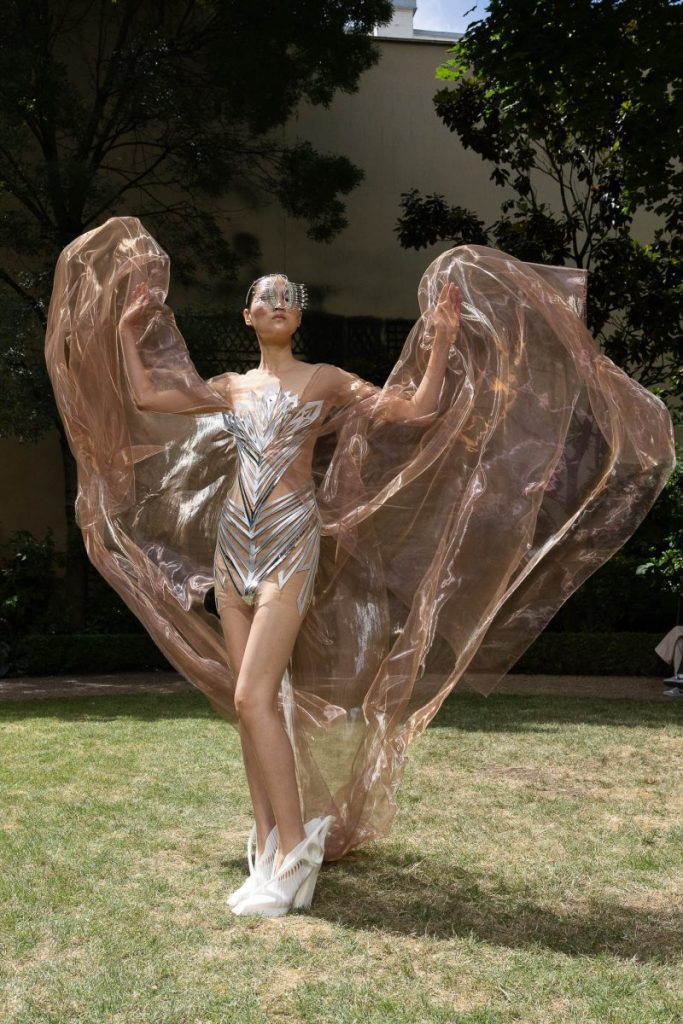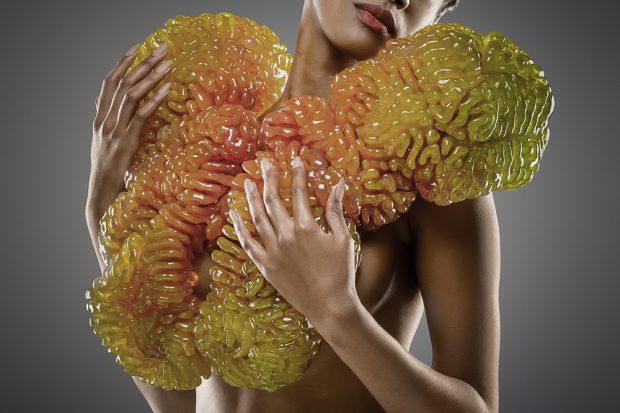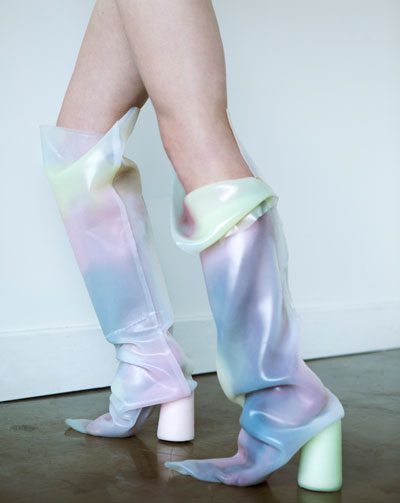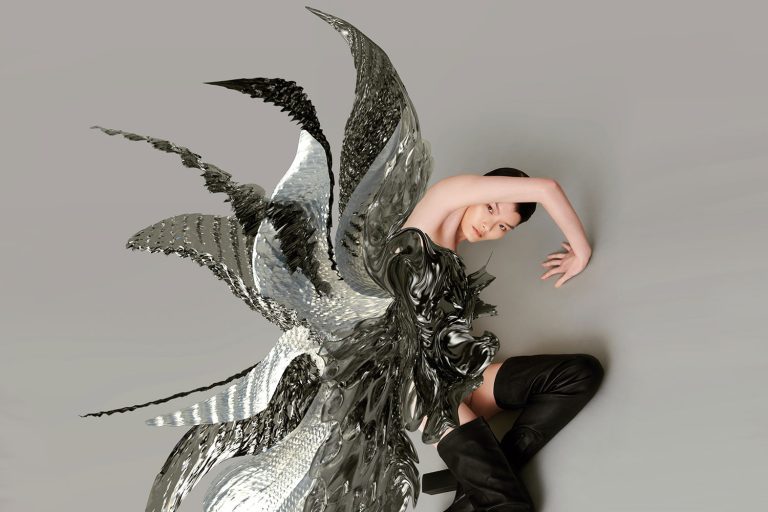
Architectonics FW 2023
Courtesy of the designer

Qamar
Photography by YORAM RESHEF

Third skin, 2020
Photography by MAUDE ARSENAULT
The Digital Transformation of Art and Fashion
The transition from traditional methodologies to digital platforms has revolutionized art and fashion, integrating technology into every aspect of creation and consumption. Digital tools in fashion design, such as CAD software, have allowed designers to visualize and alter their creations with unprecedented ease and precision. In the realm of art, digital technology has enabled the creation of new mediums like digital painting and 3D modeling, providing artists with new ways to express their visions. Websites like ArtStation and the use of tablets for digital drawing have become staples in the artist’s toolkit, reflecting the significant impact of digital transformation on creative industries.
This journey is highlighted by the fashion industry’s embrace of digital sketching and pattern-making software, which has streamlined the design process and expanded creative possibilities. For example, brands like Adidas have utilized 3D printing to innovate shoe manufacturing, demonstrating the tangible impacts of digital technology on fashion production. 3D printing has also made its mark in the art world, with artists like Joshua Harker making headlines for intricate 3D-printed sculptures, showcasing how technology is expanding the boundaries of what’s possible in art and fashion.
Art in the Age of Digitalization
The digital era has ushered in new forms of art, transforming traditional galleries into virtual spaces that are accessible to a global audience. Digital art, once a niche field, has gained prominence and commercial viability, especially with the rise of NFTs, which offer a new model for owning and trading digital art. Digital artists like Beeple and Refik Anadol have utilized digital platforms to reach vast audiences, with Beeple’s NFT artwork selling for millions at auction, underscoring the lucrative potential of digital art in the current market. Platforms such as ArtSteps provide virtual gallery spaces that allow users to curate and share digital exhibitions, broadening access to art and creating new opportunities for artists to showcase their work. The sale of NFTs, like Beeple’s “Everydays: The First 5000 Days,” has revolutionized the art market, offering digital artists a new avenue for recognition and revenue.
Fashion’s New Digital Frontier
Fashion has embraced digital innovation, from online retail’s exponential growth to the use of virtual reality in showcasing collections. This digital shift has not only changed how fashion is sold but also how it is presented, with virtual fashion shows becoming a new norm. Fashion giants like Zara and H&M have significantly invested in their online platforms, responding to the increasing consumer preference for online shopping, which has been further accelerated by global events like the COVID-19 pandemic. Luxury brands such as Balenciaga have explored virtual reality to present their collections, offering immersive experiences that blend fashion with digital artistry. Augmented reality apps, like the one offered by Gucci, allow users to “try on” shoes virtually, merging digital innovation with fashion utility and enhancing the online shopping experience.
Intersecting Worlds
The intersection of art and fashion in the digital realm has led to unique collaborations that merge creative visions, influencing both industries. Digital art has found its way into fashion design, with patterns and prints inspired by digital motifs becoming increasingly popular. Collaborations, such as the Louis Vuitton x Jeff Koons collection, where iconic artworks were transposed onto luxury bags, illustrate the deepening relationship between art and fashion in the digital age. Digital motifs and aesthetics have been increasingly incorporated into fashion designs, with brands like Prada and Off-White incorporating digital and futuristic themes into their collections, reflecting the influence of digital culture on fashion trends.
Social Media in Art and Fashion Communities
Social media platforms have become central to the dissemination of art and fashion, enabling artists and designers to directly engage with their audiences. Influencers play a pivotal role in shaping trends, while user-generated content fosters a democratized environment for art and fashion. Influencers such as Chiara Ferragni have leveraged social media to set and propagate fashion trends, demonstrating the powerful role of social media in shaping public tastes and preferences in the fashion industry. Platforms like Instagram and TikTok have democratized fashion and art, enabling users to share their own creations and interpretations, thus influencing trends and bringing forth fresh perspectives on style and artistry. This open platform for sharing has allowed for a broader range of voices to be heard, further enriching the cultural tapestry of both fields.
The Sustainability Question
As the digital influence grows, so does the focus on sustainability within art and fashion, encouraging both industries to reconsider their practices in light of environmental concerns and ethical considerations. Sustainable fashion brands like Patagonia are using digital platforms to promote eco-friendly practices, from sourcing sustainable materials to advocating for ethical production methods, highlighting the industry’s shift towards more responsible practices. The challenge of balancing digital growth with sustainability is significant, with solutions ranging from digital fashion pieces that reduce physical waste to online platforms that facilitate the resale and recycling of art and fashion items, promoting a more sustainable approach to consumption.
Future Perspectives
The future of art and fashion in the digital realm is ripe with potential for innovation, from AI-driven design to blockchain’s role in authenticating digital art and fashion items. Emerging technologies, such as AI-generated art and fashion, are set to further revolutionize these industries, offering personalized and unique creative experiences that were previously unimaginable. AI’s role in creative processes is expanding, from generating art to aiding in fashion design and trend prediction, demonstrating the technology’s potential to transform traditional creative methodologies.
Redefining Art and Fashion
The integration of digital culture into art and fashion has not only reshaped these industries but also redefined perceptions of creativity and expression. As digital advancements continue to evolve, they will further blur the lines between art, fashion, and technology, creating new opportunities for collaboration and innovation. The future of art and fashion in the digital age promises a landscape where these industries continue to influence and inspire one another, driving forward a new era of digital artistic and fashion expression.
Fashion has entered a new dimension — interactive, intelligent, and immersive. Keep reading to uncover how AR powers virtual try-ons, mall pop-ups, and digital-only couture.

